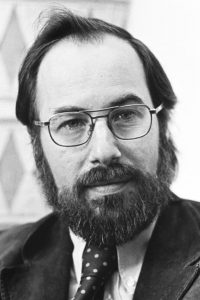David Baltimore
Post 1, Nicolas Burton
Early Life and Education
David Baltimore was born on March 7th, 1938, in New York, New York. His parents were Richard and Gertrude Baltimore, who raised David within Queens until the second grade, where he was further moved to Great Neck, New York because his mother felt the city schools to be inadequate. As a student, Baltimore had exceeded his expectations in math, but immediately built up a deep love for science. While still a secondary school student, he spent a spring at the Jackson Memorial Laboratory in Bar Harbor, Maine, experiencing science in its true nature. Following this, he aimed and succeeded in entering Swarthmore College in 1956, proclaiming himself a science major following the previous events in life. Later, he followed it up with an exploration postulation, which is an examination report, typically a prerequisite for graduation. He graduated in 1960 with a four-year certification or a bachelor’s degree, and upon graduation had received high praise from both his peers and teachers. Between his sophomore and junior years at Swarthmore, he spent a spring at Cold Spring Harbor Laboratories where the impact of George Streisinger drove him to divulge into sub-atomic science, which is technically science about the structure and advancement of natural frameworks.
Post-Graduate Life and Studies
Following his years at Swarthmore, he proceeded to enroll for two years at the Massachusetts Institute of Technology (MIT) in biophysics to complete graduate work. During this, he left for another spring to go from the Albert Einstein Medical College to take an infection course at Cold Spring Harbor under Richard Franklin and Edward Simon, two esteemed scientists within his interested field. After a year here, he proceeded to join Salk Institute of Biological Studies as an examination partner, where he became friends and worked closely with Renato Dulbecco. He met his wife at the same location, Alice S. Huang, and they became married on October 5th, 1968. After marrying Alice and studying as an examination partner, he followed it up by becoming a full professor within MIT, after which he joined the staff of the MIT Center for Cancer Research under Salvador Luria in 1974.
Throughout his studies, he received several honors, mainly for his work in malignant growth examine. Within the year 1971, he was the beneficiary of the Gustav Stern honor in virology, which is the study of infections, the Warren Triennial Prize, and the Eli Lilly and Co. grant in microbiology, which is a study that examines the minuscule living things. In addition to the previous, he received honors in immunology as well, which is a part of science that includes the investigation of safe framework. His most honorable title received was the Nobel Prize in Physiology and Medicine that he shared with Howard M. Temin and Renato Dulbecco for research regarding retrovirus and malignancy, retroviruses referring to a sort of infections.
Main Research
One of the main focal points of Baltimore’s research was the discovery of reverse transcriptase. Essentially, this was enzyme to used to generate complementary DNA from an RNA template. The research they contributed proved that the progression of hereditary data within the infections didn’t need to go from DNA to RNA, however, they could spill out of RNA and DNA, which further showed that it was a game-changer towards the overall belief of the molecular biology. This in basic terms was a solution towards a series of infections and finding ways to treat them, through the understanding of how viruses reproduce themselves.
Summary/Reflection
With the rising levels of medical advancements in recent years, the findings of Baltimore are nothing short than revolutionary. Between the Noble Prize (referenced with the picture below) and the National Medals of Science and Technology he received from Bill Clinton in 2000, the belief that Baltimore’s research has heavily influenced modern medicine is clearly observational. Although his research is spread across several different subsets of biology, his main contributions seemed to be towards molecular biology, immunology, and virology. Comparing David’s life to my own, he clearly is much more into biology than I. However, I can agree with him on the importance and interest of Stem Cell Research. Stem Cell seemingly will be a big part of the future, looking like it will be leading medical advancements with better understanding as it includes the growing of working organs and new cells from using basic practices. I would say it rivals with the advancement of AI within the computer science community which I am looking forward to joining.
Figure 1: Pictured is David Baltimore from the Noble Prize’s main website, “The Nobel Prize in Physiology or Medicine 1975.” NobelPrize.org, www.nobelprize.org/prizes/medicine/1975/baltimore/biographical/.

Work Cited
Coffin, John M. “Overview of Reverse Transcription.” Retroviruses., U.S. National Library of Medicine, 1 Jan. 1997, www.ncbi.nlm.nih.gov/books/NBK19424
“David Baltimore Biography.” Encyclopedia of World Biography, www.notablebiographies.com/Ba-Be/Baltimore-David.html.
“The Nobel Prize in Physiology or Medicine 1975.” NobelPrize.org, www.nobelprize.org/prizes/medicine/1975/baltimore/biographical/.